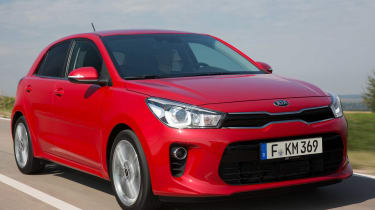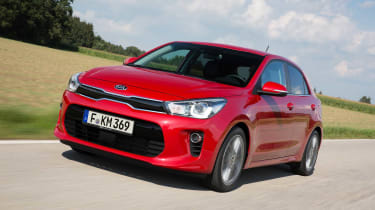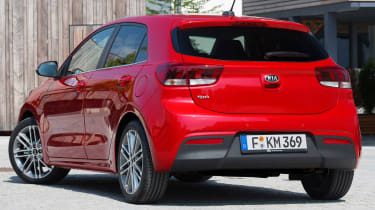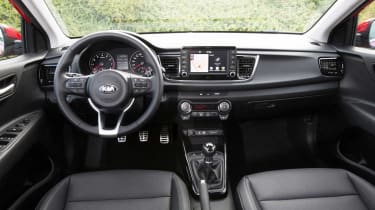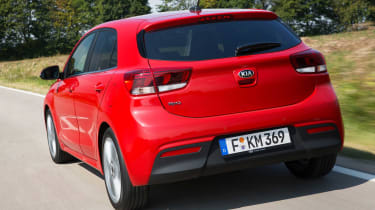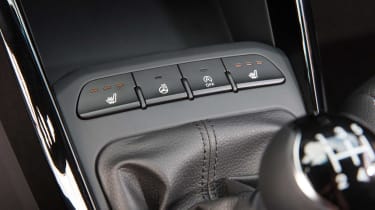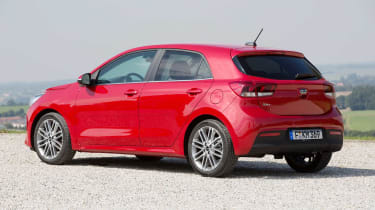New Kia Rio arrives late 2016
We've got all the details, and new pictures of 2017's new Kia Rio.
After the first official images of the new Kia Rio were revealed earlier this year, more pictures and further details – including engine specifications – were announced after its official reveal at the 2016 Paris Motor Show.
The new car is longer, lower and wider than the one it replaces, while there’s also emphasis on improved technology, practicality and driving fun and a new turbocharged 1.0-litre petrol is the big news under the bonnet. For this generation of the Rio, Kia has also targeted a five-star Euro NCAP safety score, meaning a significant increase in standard active safety kit.
The new Kia Rio is based on a brand-new platform and when it goes on sale later in the year, it’ll be up against rivals like the Vauxhall Corsa, Volkswagen Polo, Skoda Fabia, Honda Jazz, Hyundai i20 and SEAT Ibiza. This platform will also spawn a new compact crossover that’s design to take on the growing batch of supermini/SUVs on the market, such as the Peugeot 2008, Citroen C4 Cactus, Renault Captur, Vauxhall Mokka, Ford EcoSport and Audi Q2.
The new Kia Rio is on sale now – read our review here.
New Kia Rio design
This next iteration of the Kia Rio has been, in terms of design at least, a collaborative effort between the company’s stylists in South Korea, Germany and California. There are definite hints of the Hyundai i20 – the equivalent model in Kia’s sister brand’s range – about the front end, with slender headlights that wrap around the front bumper. Meanwhile, the front of the car is much more bluff and upright compared to the outgoing Rio, which was a fair bit curvier than this more squared-off iteration.
You won’t be surprised to learn that, as on every recent Kia, the ‘Tiger Nose’ grille is present, although on the Rio it’s not as deep as before, while it’s also much wider. Kia has altered the proportions of the new Rio, too, giving it a longer bonnet, a longer front overhang (the distance between the front wheels and the front of the car) to give the car a more ‘cab-backward’ stance. To emphasise this, the rear overhangs – the distance between the rear wheels and the back of the car – have also been shortened.
Overall, this Rio is 15mm longer, 5mm wider and 10mm lower than the previous model, in an attempt to give it a sportier stance. It also has a much more angular shape than the outgoing model, with the overall theme being one of straight lines rather than curves.
This continues along the sides of the car and all the way to the back, with a line that goes all the way from the front grille, through the headlights and along the window line right round to the rear of the car. At the back, there are thinner rear lights, which are now LEDs, while the near-vertical tailgate continues the angular design theme.
Interior
Inside, lines also dominate, with the dashboard featuring two horizontal lines along its full width. It also has four rhomboid-shaped air vents, the centre two of which sit either side of a new ‘floating’ touchscreen infotainment system, which incorporates new connectivity and navigation functions.
This new touchscreen has allowed Kia to reduce the number of buttons in the new Rio and the few left mostly sit below the screen and control the air-con.
You’ll be able to specify your Rio with either black or grey cloth upholstery, which can be brightened by the addition of a ‘Red Pack’. This adds faux red leather trimming for all the seats, while the dashboard and the rest of the interior is trimmed in gloss-black and metallic-finish plastics.
Technology & equipment
All cars will come with a five-inch touchscreen infotainment system on top of the dashboard, which can be specified with either Apple CarPlay or Android Auto mobile phone compatibility software. These systems allow you to control certain functions of your phone from the car’s own touchscreen, allowing you to make calls, access media, use navigation apps and even listen to and dictate responses to text messages.
You’ll also be able to access Kia’s Connected Services connectivity package. This is powered by sat-nav company TomTom and includes navigation, as well as live traffic updates, weather forecasts, speed-camera locations and alerts (where legal) and local point-of-interest suggestions. Owners get seven years’ free subscription to the service.
Engines
Most of the new Kia Rio’s engine range has been either carried over from the existing car or taken from elsewhere in the brand’s range.
There are two non-turbo petrol engines – a 1.25 and 1.4-litre – managing 83 and 99bhp respectively, while there’ll also be a 1.4-litre diesel. This will be available with either 69 or 89bhp.
The big news, however, is the addition of a turbocharged 1.0-litre three-cylinder petrol engine. This will be available with either 99 or 118bhp and in both cases is expected to emit less than 100g/km of CO2, so it’ll be free to tax in the UK if bought before April 2017.
Across the rest of the range, the 1.25 and 1.4-litre petrols are both expected to deliver CO2 emissions of less than 120g/km. This means that neither should cost more than £30 a year to tax.
The diesels are expected to be the cheapest to run, however, with Kia’s engineers targeting CO2 emissions of under 90g/km for both versions. This will mean no road tax and a very low Benefit-in-Kind (BiK) company-car tax rate of just 18%.
Front-wheel drive is standard across the range, with the 1.2 and 99bhp 1.0-litre turbo coming with a five-speed manual gearbox as standard. The rest of the engines come with a six-speed manual.
Ride & handling
Kia hopes the new Rio will boast improved ride and handling characteristics compared to the previous model. This is because it’ll benefit from the input of former BMW engineer Albert Biermann, who now works on the driving dynamics of cars from Kia and its sister brand Hyundai.
Practicality
Kia is promising class-leading interior space, as well as an impressive 325 litres of boot space. The wheelbase (distance between the front and rear wheels) has grown by 10mm compared to the previous model, which means there’s now 770mm of legroom in the back seats.
The company is also claiming more shoulder room – 1,375mm in the front and 1,355 in the back – than ever before, while despite the fact that the roofline has dropped, there’s more headroom as well.
Both front doors have a bottle holder large enough to carry a 1.5-litre bottle, while those in the back can carry a 500ml drinks bottle. There are various other cubbies, too, while buyers can specify an arm rest which adds even more storage space.
Safety
Kia has also put a heavy emphasis on safety for the new Rio. Not only will it come with a selection of new active safety and driver assistance systems, but it’s also been built using a significantly higher proportion of high-strength steel, which is both lighter and stronger than standard steel. The new car will be made out of 51% of this material, as opposed to 33% for the outgoing car.
The company is targeting a five-star Euro NCAP rating with the new car and, to that end, Kia says the new Rio will be the first car in its class to come with autonomous emergency braking with pedestrian recognition. This uses a radar system to detect any potential obstacles or impending collisions and warns the driver before automatically applying the brakes and bringing the car to a stop if the driver doesn’t react.
Also fitted to the new Kia Rio will be lane-departure warning, six airbags and ISOFIX child-seat mounting points on the front and rear passenger seats.
Price & on-sale date
Production of the new Rio for the UK market is set to begin towards the end of 2016, with first deliveries likely to start early in 2017, although we don’t have an exact date just yet. Pricing is also unconfirmed for now, but you’re likely to have to pay slightly more than the current car’s £11,000 starting figure.
Recommended
Most Popular

New Smart #5 Brabus is a 637bhp far cry from the brand’s city car past

Best car leasing deals 2025: this week’s top PCH offers
Tips & advice

Car dashboard warning lights: what does each symbol mean?

Electric car charging stations: public networks, charger types, apps and maps


